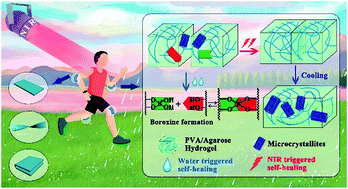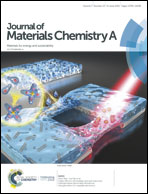Highly efficient self-healable and dual responsive hydrogel-based deformable triboelectric nanogenerators for wearable electronics†
Abstract
Self-healable soft conductors, which can withstand certain degrees of deformation and can recover from damage spontaneously, are essential for wearable applications. In this work, a soft hydrogel based self-healing triboelectric nanogenerator (HS-TENG), which is highly deformable, and both mechanically and electrically self-healable, has been successfully fabricated from a poly(vinyl alcohol)/agarose hydrogel. The incorporation of photothermally active polydopamine particles and multiwalled carbon nanotubes (MWCNTs) allows the HS-TENG to be physically self-healed in ∼1 min upon exposure to near-infrared (NIR) light. At the same time, the chemical self-healing of the HS-TENG can be triggered by water spraying at 25 °C when introducing water-active dynamic borate bonds into the hydrogel. The applicability of the HS-TENG as a soft energy device to harvest human motion energies has been demonstrated. By tapping the HS-TENG with various deformations, the rectified electricity can charge commercial LEDs with sustainable energy. Working in single-electrode mode, the electrical outputs of the HS-TENG in terms of short-circuit transferred charge (Qsc), open circuit voltage (Voc) and short-circuit current (Isc) reach ∼32 nC, ∼95 V and ∼1.5 μA, respectively, and remain stable even with 200% strain since the MWCNTs disperse evenly in the matrix and play the role of conductive fillers in the HS-TENG.



 Please wait while we load your content...
Please wait while we load your content...